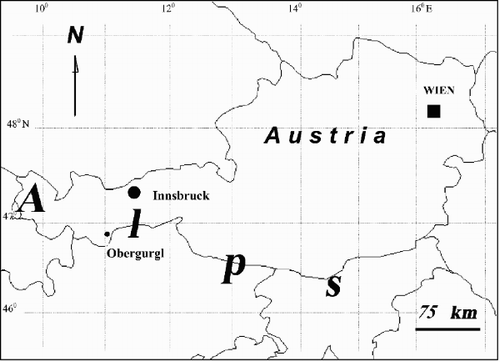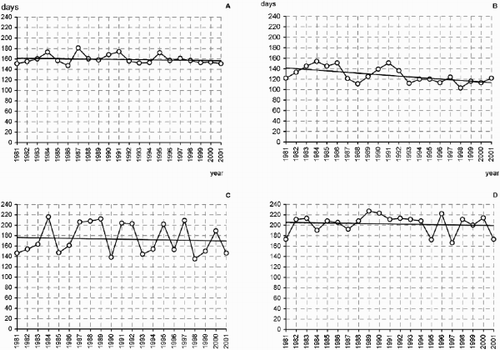Abstract
Airborne pollen concentration was analysed for six plant taxa for the years 1980–2001 and related to temperature records for the same interval in two different areas in Austria. Both in valley areas (Innsbruck) and at higher altitudes (Obergurgl) the flowering period starts earlier, and lasts longer, and the peak values and pollen production were found to increase. Thus the potential for allergic responses to pollen has considerably increased.
Since 1977, the Tyrolean Pollen Warning Service has been operated by the Institute of Botany, University of Innsbruck, supported by the Health Department of the Tyrolean provincial government. It started with three Burkard 7‐day recording volumetric samplers in the Inn valley at the main areas of settlement (Innsbruck, Wörgl and Imst). Only the sampler in Innsbruck was operated all year round and used as a reference sampler. The other samplers collected only during the growth period. In 1980, the samplers in the valley bottom were complemented by traps at high altitudes in Obergurgl and later in Kühtai and Galtür. At present ten pollen samplers are being operated in Tyrol (http://botany.uibk.ac.at).
This series of observations for over 20 years allows a statistical evaluation of the start of the flowering period, the main flowering period, pollen output and productivity. For this first statistical long‐term evaluation of data from the Tyrolean Pollen Warning Service, the following six pollen types were taken into account:
| 1. | Alnus: A group including both species flowering in spring in the valley – Alnus incana, A. glutinosa – and species flowering in summer at high altitudes – A viridis. | ||||
| 2. | Corylus: One species flowering in spring at lower altitudes (Corylus avellana). | ||||
| 3. | Betula: Present as a species in numerous parks in Innsbruck and as a group of species becoming less frequent with increasing altitude (Betula armanii, B. jungii, B. nigra, B. papyrifera, B. pendula, B. utilis). | ||||
| 4. | Fraxinus: One species flowering in early summer at lower altitudes (Fraxinus excelsior). | ||||
| 5. | Pinus: A genus very common from the valley to the treeline (Pinus cembra, P. mugo, P. nigra, P. sylvestris). | ||||
| 6. | Poaceae: A very large group of species and genera which is the most common cause of allergic reactions. | ||||
As expected, the start of the flowering period, the duration of the flowering period and overall pollen output relate primarily to weather conditions. Fritz et al. (Citation1985) collected empirical values for the start of the flowering period of several pollen types and related them to a certain temperature sum in a certain period. For Alnus and Corylus the period starts on 1st December and the accumulated daily temperature must reach 300°C. For Betula the beginning of the flowering period is 1st March (0°C) and the accumulated temperature sum must reach 450°C. The flowering period starts with the steep rise of the pollen curve. Precipitation and low temperatures during the flowering period may stop pollen dispersal. Bortenschlager et al. (Citation1998), studied pollen rain at the timber line in Obergurgl, and showed that the total amount of pollen produced depended strongly on temperature and precipitation during the vegetation period of the previous year. Special weather conditions, such as foehn (warm winds), also have a strong impact on the start of the flowering period and on maximum pollen output, especially in spring in the valleys (Innsbruck). This causes problems when pollen rain data from different sites, especially among species flowering in spring, is compared. In order to avoid these difficulties the analysis has to be limited to trend values. In this study, the results of the Innsbruck pollen trap at the valley bottom and the Obergurgl pollen trap at high altitude will be presented.
MATERIAL AND METHODS
The pollen data were obtained with Burkard 7‐day recording volumetric samplers and the analysis method follows that of Käpylä & Penttinen (Citation1981).
The pollen sampler in Innsbruck (620 m asl) is located at the meteorological station of the Institute of Meteorology on the roof of the Bruno‐Sander‐Haus (University of Innsbruck), approximately 35 m above the ground ().
The Burkard sampler in Obergurgl (1938 m asl) is located next to the meteorological station, 4 m above the ground, on the site of the Alpine Research Station ().
RESULTS AND DISCUSSION
Temperature records
The monthly mean values of temperature show an increasing trend both for Innsbruck and Obergurgl for the period 1981–2001 (). The average temperature increased by 1.5° in Innsbruck and by 0.4° in Obergurgl. The less pronounced increase at the higher altitude is a well‐known phenomenon in the Alps (Beniston et al. Citation1994).
Fig. 2. A. Mean air temperature in Innsbruck for the period 1980–2001, showing an increase of 1.5°C. B. Mean air temperature in Innsbruck for the first quarter of the year (Jan/Feb/March), i.e. the crucial period for the flowering of Alnus, Corylus, Betula, for the period 1980–2001, showing an increase of 2.6°C. C. Mean air temperature in Obergurgl for the period 1981–2001, showing an increase by 0.4°C. D. Mean air temperature in Obergurgl during the vegetation period (April ‐ August) for the period 1980–2001, showing an increase of 0.6°C.
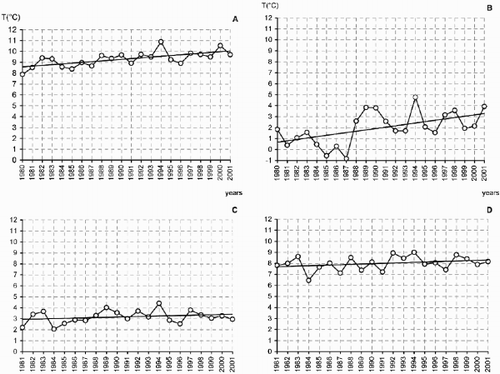
Flowering periods
Our data shows that the increase in temperature is paralleled by a change in the starting date of flowering period. Although foehn conditions in certain years complicate the picture.
Phenological observations (Fitter & Fitter Citation2002, Menzel & Fabian Citation1999) precisely defined the start of the local flowering period. The start of the local flowering period in pollen dispersal studies is less clear and cannot be set, for example, at the moment the first pollen are registered, because pollen disperses over long distances. Some authors define the start of the flowering period when pollen occurs continuously above a certain value. Frenguelli et al. (Citation1991) defines the start of the flowering period when pollen accounts for 1% of the annual sum. Andersen (Citation1991), however, suggests a value of 2.5% of the annual sum to represent the onset of the flowering period, but his predictive model allows for errors of 2–3 days and in some cases even 8–10 days.
In Innsbruck the problem is even more complicated due to the local weather conditions influenced by the high relief. During a foehn period Corylus may already flower in December, and reach high values causing allergic reactions for several days. This type of foehn period may also occur throughout the winter; thus Alnus and Corylus may flower intensively during the time of the warm winds and stop during the following cold period ().
Table I. Influence of foehn in Innsbruck, early blooming of Alnus in December (Bortenschlager et al. Citation1990).
Therefore the actual start of the flowering period does not have a suitable value when compared with spring pollen types during different years in Innsbruck. In order to be able to compare different years and to obtain a representative value, the centre of gravity (RP) of the area enclosed by the curve was calculated for the whole flowering period of a pollen type and the position of these centres of gravity were compared. The ‘centre of gravity’ is the temporal centre of the pollen curve, weighted with day‐by‐day values. As shows this centre of gravity, for example, in Innsbruck may be found close to the moment of maximum flowering, such as shown by Corylus, Fraxinus and Betula or considerably later if the flowering period is longer, such as shown by Betula and Poaceae. In Obergurgl () a similar picture is found, with an even stronger temporal shift between maximum flowering and centre of gravity among Poaceae. This is probably due to the great number of different species and long distance transport.
Fig. 3. Construction of the centre of gravity of the area included by the pollen curve for 2001 in Innsbruck: A. Alnus, B. Corylus, C. Betula, D. Fraxinus, E. Pinus, and F. Poaceae.
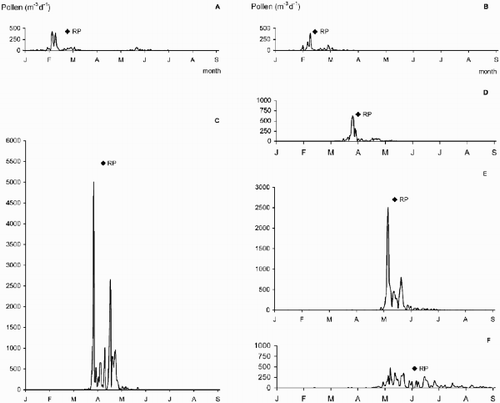
Fig. 4. Construction of the centre of gravity of the area included by the pollen curve for 2001 in Obergurgl: A. Alnus, B. Betula, C. Pinus, and D. Poaceae.
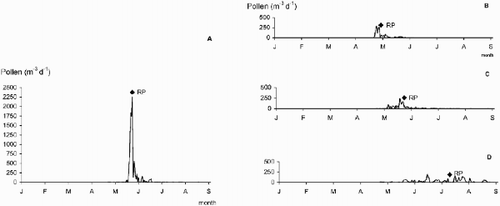
The regression line for the centres of gravity for each pollen type shows a shift towards an earlier start of the flowering period for all pollen types, both in Innsbruck () and in Obergurgl (). This was also found by Frei (Citation1998) for Switzerland and by Emberlin et al. (Citation1997) for England.
Fig. 5. Onset of the flowering period in Innsbruck (in days): A. Alnus (−10.3); B. Corylus (−17.8); C. Betula (−8.7); D. Fraxinus (−7.1); E. Pinus (−12.8); F. Poaceae (−10).
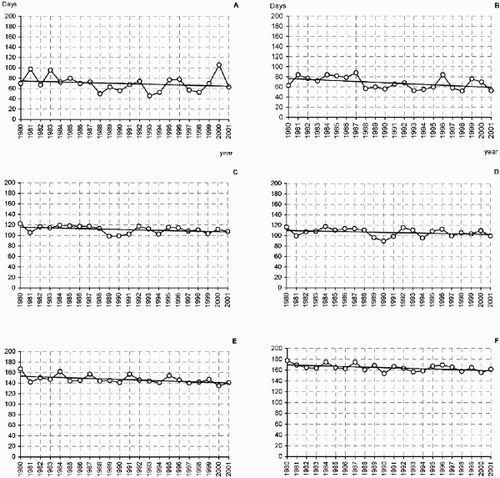
Fig. 6. Onset of the flowering period in Obergurgl (in days): A. Alnus (−13.1); B. Betula (−16.1); C. Pinus (−24.3); D. Poaceae (−5.7).
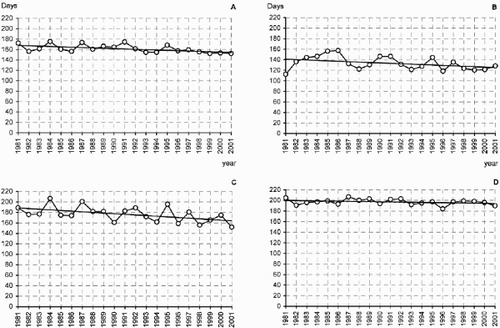
This trend to earlier onset of the flowering period ranges from 7.1 days for Fraxinus to 17.8 days for Corylus in Innsbruck. This extremely high interannual variability for Corylus is caused by the onset of flowering due to foehn in December of the previous year (see ). The average shift for all taxa in Innsbruck amounts to 11.1 days, or about 9.8 days if Corylus is not taken into account. These values correspond well with the prolongation of the vegetation period in Europe by 10.8 days found by Menzel & Fabian (Citation1999). Also the fact that the vegetation period starts 8 days earlier and ends 4 days later in areas between 45°N and 70°N, found by Penuelas & Filella (Citation2001), based on satellite data, corresponds well with the data obtained here.
Even more extreme shifts of the centre of gravity, indicating an earlier start of the flowering period, are found in the values of four pollen types in the Obergurgl pollen trap (). Corylus and Fraxinus do not occur at this altitude.
At the timber line even the slightest increase in temperature has substantial significance. The increase of the average temperature in Obergurgl of 0.4° would mean that the vegetation limits would rise by only 30 m. However, if the length of the vegetation period is taken into account and the increase of the mean values of temperature for the months of May to August is analysed, a more significant increase of 0.6° is found ().
The average shift of the flowering centre of gravity in Obergurgl is 14.6 days. This mean value is affected by the low value of Poaceae. If Poaceae were excluded, the mean shift would be as high as 17.8 days. The Poaceae values have to be assessed critically because mowing the grassland in Obergurgl may put an early end to the flowering period.
Maximum pollen output
The day of maximum pollen output is influenced by several parameters, with the current weather conditions during the flowering period certainly exerting the strongest influence. Precipitations during the flowering phase washes out all atmospheric pollen and thus reduces pollen dispersal, as Frei (Citation1998) showed for Betula and Poaceae.
In spite of some uncertainties, the days of maximum pollen amount also show a consistent trend towards earlier dates.
For the six pollen types, the Innsbruck pollen trap shows an average shift to earlier dates of 6.5 days, with Alnus, showing a delay of 2 days. The reason for this is the influence of the summer flowering Alnus viridis at high altitudes. If Alnus is excluded the average advancement of maximum pollen output amounts to 8.2 days ().
Fig. 7. Development of the day of maximum pollen output, i.e. maximum charge for allergic people, in Innsbruck: A. Alnus (+2); B. Corylus (−11.9); C. Betula (−14); D. Fraxinus (−3); E. Pinus (−1.9); F. Poaceae (−10.3).
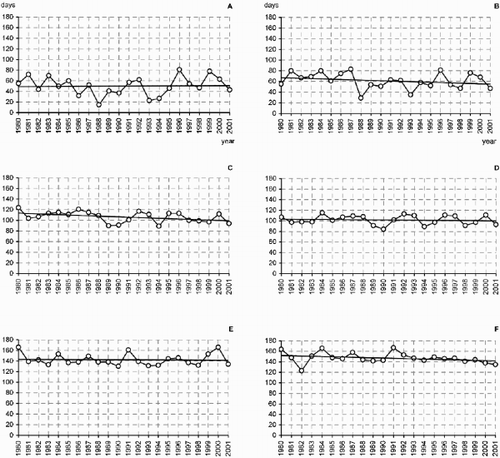
The Obergurgl pollen trap shows a shift for all four pollen types, amounting to 11.4 days on average. If the extreme value of Betula (28.3 days) is excluded, the average value amounts to 5.8 days. The extreme value of Betula is presumably due to long‐distance dispersal of pollen from lower altitudes ().
Annual pollen productivity
The pollen types taken into account for this analysis show no interannual flowering rhythm like, for example, Picea (Ambach et al. Citation1969) and thus pollen production for the total population mainly depends on climatic factors. More favourable climatic conditions should result in higher annual productivity, i.e. in a higher pollen sum. A significant change in vegetation, which could also influence the pollen sum, can be excluded for both sites analysed.
and show an increasing trend in the pollen sum for all pollen types observed for the 20 year period.
Fig. 9. Development of the total amount of pollen (PK per m3 and year) in Innsbruck. The starting and final values were determined by the regression line: Alnus (×2.5), Corylus (×2.4), Betula (×1.2), Fraxinus (×6.5), Pinus (×3.2), Poaceae (×2.9).
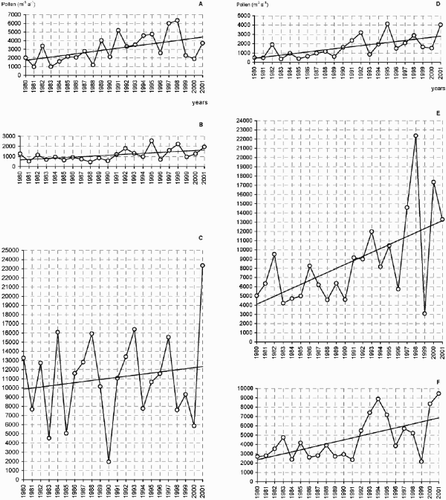
Fig. 10. Development of the total amount of pollen (PK per m3 and year) in Obergurgl. The starting and final values were determined by the regression line: Alnus (–), Betula (×7.7), Pinus (×2.7), Poaceae (×1.9).
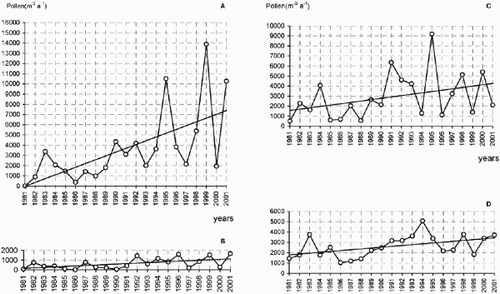
The trend lines show an increase that documents for most species nearly a doubling or even a tripling of pollen sums and thus indirectly of pollen production. Fraxinus in Innsbruck, where the increase is by the factor 6.5, is top of the list. The lowest increase is found for Betula in Innsbruck (about 20%). The Alnus and Betula values in Obergurgl are problematic because of the long distance transport and the very low values for the years from 1981 to approximately 1990. Alnus viridis was able to spread heavily since 1990 under the protection of the avalanche control infrastructure installed at that time.
The fact that species flowering in spring were especially favoured by temperature change can also be seen by the increase of mean temperatures for the months of January/February/March, which in Innsbruck amounts to 2.6° for the period observed ().
Consequences for people suffering from allergy
Although, with the exception of Pinus, only types of allergological relevance were discussed here, we can document that the changes in temperature in Innsbruck and Obergurgl during the last 22 years have led to a strong increase in the potential health impact for people suffering from pollen allergies. This is due, on the one hand, to an earlier start of the flowering period (, ) and thus a longer flowering period and, on the other hand, to higher pollen production (, ) that led to higher peaks in pollen dispersal (, ). More precise information thus becomes increasingly important also in terms of being able to avoid allergens.
References
REFERENCES
- Ambach , W , Bortenschlager , S and Eisner , H . 1969 . Untersuchung von charakteristischen Pollenspektren im Akkumulationsgebiet eines Alpengletschers (Kesselwandferner, Ötztaler Alpen, Österreich). . – Pollen Spores , 11 : 65 – 72 .
- Andersen , TB . 1991 . A model to predict the beginning of the pollen season. . – Grana , 30 : 269 – 275 .
- Auer , I , Böhm , R and Schöner , W . 2001 . Austrian Long‐term Climate 1767–2000 (ALOCLIM). . – Österr. Beitr. Meteorol. Geophys. (Wien) , 25 : 1 – 147 .
- Beniston , M , Rebetez , M , Giorgi , F and Marinucci , MR . 1994 . An analysis of regional climate change in Switzerland. . – Theor. Appl. Climatol. , 49 : 135 – 159 .
- Bortenschlager , S . 1990 . Pollenflugsaison 1989 in Österreich. . – Ber. Naturwiss.‐Mediz. Ver. (Innsbruck) , Suppl.7 : 1 – 91 .
- Bortenschlager , I and Bortenschlager , S . 2001 . Pollenflug 2000 in Tirol (Öästerreich) Galtür, Innsbruck, Lienz, Obergurgl, Reutte, St. Sigmund, Wörgl und Zams. . – Ber. Naturwiss.–Mediz. Ver. (Innsbruck) , 88 : 29 – 55 .
- Bortenschlager , S , Bobek , M , Bortenschlager , I , Brosch , U , Cerny , M , Drescher‐Schneider , R , Ehmer‐Künkele , U , Fritz , A , Jäger , S and Schmidt , R . 1990 . Pollensaison 1989 in Österreich. . – Ber. Naturwiss.‐Mediz. Ver. (Innsbruck) , Suppl. 7 : 1 – 91 .
- Bortenschlager , S , Kofler , W , Nicolussi , K , Oeggl , K and Wahlmüller , N . 1998 . The FOREST project: sensitivity of Northern, Alpine and Mediterranean Forest limits to climate – final report of the Innsbruck‐group. . – Inst. Hochgebirgsforsch. Innsbruck Jahresber. , 1998 : 47 – 65 .
- Emberlin , J , Detandt , M , Gehrig , R , Jaeger , S , Nolard , N and Rantio‐Lehtimäki , A . 2002 . Responses in the start of Betula (birch) pollen seasons to recent changes in spring temperatures across Europe. . – J. Biometeor. , 46 : 159 – 170 .
- Emberlin , J , Mullins , J , Corden , J , Millington , W , Brooke , M , Savage , M and Jones , S . 1997 . The trend to earlier birch pollen seasons in the U. K.: A biotic response to changes in weather conditions. . – Grana , 36 : 29 – 33 .
- Fitter , AH and Fitter , RSR . 2002 . Rapid changes in flowering time in British plants. . – Science , 296 : 1689 – 1691 .
- Fornacari , M , Pieroni , L , Ciuchi , P and Romano , B . 1998 . A regression model for the start of the pollen season in Olea europaea. . – Grana , 37 : 110 – 113 .
- Frei , T . 1998 . The effects of climate change in Switzerland 1969–1996 on airborne pollen quantities from hazel, birch and grass. . – Grana , 37 : 172 – 179 .
- Frenguelli , G , Spieksma , FTh. M , Bricchi , E , Romano , B , Mincigrucci , G , Nikkels , AH , Dankaart , W and Ferranti , F . 1991 . The influence of air temperature on the starting dates of the pollen season of Alnus and Populus. . – Grana , 30 : 169 – 200 .
- Fritz , A , Liebich , E and Zwander , H . 1985 . Der Pollenwarndienst in Kärnten. . – Carinthia II , 175/95 : 1 – 26 .
- Käpylä , M and Penttinen , A . 1981 . An evaluation of the microscopical counting methods of the tape in Hirst‐Burkard pollen and spore trap. . – Grana , 20 : 131 – 141 .
- Menzel , A and Fabian , P . 1999 . Growing season extended in Europe. . – Nature , 397 : 659
- Penuelas , J and Filella , J . 2001 . Responses to a Warming World. . – Science , 294 : 793 – 795 .
